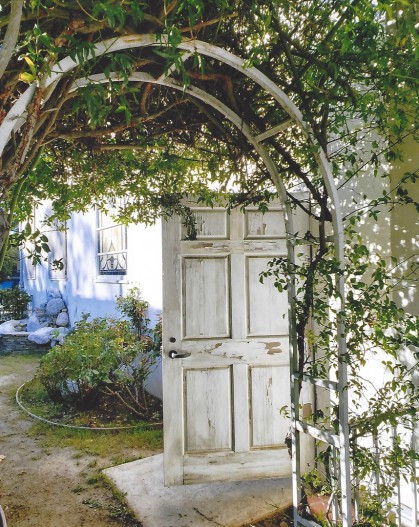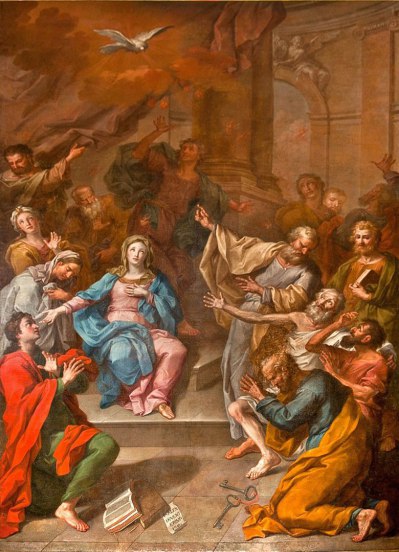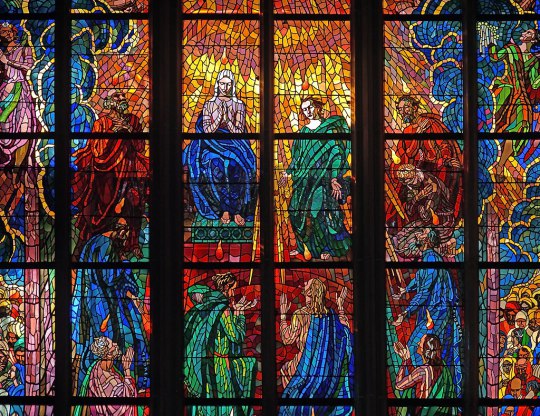
May 2021
May 28, 2021
Thoughts of Re-Opening
Our church is currently planning to re-open for in-person worship on June 20, which will be five days after the planned re-opening of the state of California. Although we don’t yet fully know what that will look like for worship celebrations, we are getting some sense of the guidance and possibilities that will be with us at that point. Depending upon where you live, your church may have already begun that in-person worship again.
But whether you are already open, or are making plans as we are, there is before us a powerful opportunity to engage with creativity and the arts. While some things will feel familiar in gathering again in-person, there may still be some restrictions in place, particularly with the possible wearing of masks yet and the advice to hold off on congregational singing. Our task then is to provide as welcoming a place as possible for folks.
I began writing this blog on Pentecost, with the image of the powerful wind very much in mind. We don’t know what that upper room looked like into which the wind entered, although we can assume we would have seen one or more doors and quite a few windows, which makes me think of opening doors and windows as a way of creatively re-opening the church for people.
There are of course the literal doors and windows of any church, which health departments have advised having open for good air circulation. But I am looking here for more than adherence to health guidelines, and thinking of how we can open doors and windows both artistically and metaphorically.
One of the artistic ways of opening doors and windows is through providing photographs of them, or images of paintings of them, and integrating those photos and images into the liturgy of the worship, however formal or informal that liturgy might be. This can become a creative activity for worship planners. One can of course get photos of doors and windows online. But how much more powerful can the experience be, for both the planners and the worshippers, to take one’s own photos, to show spaces that are personal to the photographer or even shared by the congregation itself?
The following is a photograph taken by one of my church members of an open door in our rose garden area. The door and walls were actually painted in the course of the pandemic, but the rustic view and peeling paint present a view to me that is quite inviting. Church members will recognize the door.
One photo, or a variety of photos, can be printed on the cover of the worship bulletin, if that is something you use. If you have pre-printed bulletins, photos could be inserted into them. If you don’t use them, photos could simply be spread on a table near the doors and people could choose one as they enter. Alternatively, the images could be woven into a PowerPoint presentation or something similar. The advantage of providing people with a photo is that they can hold it and reflect on it through the course of the worship experience.
Doors will evoke metaphorical images as well. Jesus knocking on the door, asking to come in, certainly will come to mind. Our knocking on God’s door in prayer will be another familiar image. You will think of more.
The use of images of windows also provides multiple possibilities of connections for people. Physical windows certainly let in light and air, but we are also familiar with “windows” of insight, as well as those that open us up to knowledge about one thing or another.
The possibilities are endless, but taking the idea of re-opening the church doors and windows to worship, and weaving it into the worship experience in ways suggested above, provides people with ways to respond to the re-opening with creativity, inspiration and joy.
May 21, 2021
Another View of Pentecost
As I reflected upon the brilliance of the stained-glass window that I highlighted last week, I decided to provide a contrast to it by bringing forth another work, this one much older, dated 1780. It is a painting of the events of Pentecost, and provides a wealth of images within the painting that tell the story from a variety of perspectives.
“Descida do Pentecostes”
Pedro Alexandrino de Carvalho, Public domain, via Wikimedia Commons
As with the stained-glass image last week, Mary the mother of Jesus figures prominently in the story. But although she is featured in the lighting that the artist has provided, she joins with almost everyone else in looking upward.
They look up toward the dove, that symbol of the Holy Spirit. The dove is flying in the midst of the fiery, mighty wind that blew through the house. Unlike so many artistic renderings of the Pentecost event, there are no individual tongues of fire resting on or above individuals, but the redness of the visible wind gives us that image of fire.
Among those in the scene, there are persons who turn away from the powerful wind, others who seem entranced by it, and still others who seem enveloped in it. One curious figure is seen on the far right, holding a book and looking down at another person as though he isn’t quite sure what is going on with that person. While the book in that person’s hand is unidentified, it is likely that the book in the foreground is the holy scriptures, perhaps turned to the Pentecost event as related in Acts 2, or just envisioned as the Hebrew scriptures, with the words of the Prophet Joel imagined to be present. Notably, the keys to the kingdom, associated with Peter, are also seen in the foreground. Then, almost unseen amidst the turmoil of the mighty wind, there is an angel or cherub watching all of this from its perch in the upper right-hand corner of the painting.
What captures my attention in this work is the feel of activity, of the powerful presence of the Spirit, of the various ways in which it has touched, empowered, or frightened those gathered in that upper room. It leads us to perhaps ask ourselves which character might be expressing our own imagined reaction had we too been in that room. This painting certainly invites us into the experience of Pentecost.
May 14, 2021
As Pentecost Nears
Pentecost is one of my favorite Sundays in the church year. It is an opportunity to celebrate the Holy Spirit, and the beautiful diversity of the family of God’s children. It tends to be colorful, to feel vibrant, and leaves one with inspiration that isn’t connected to any related traditions in the non-church world.
The celebration of Pentecost has traditionally been a time to encourage people to wear something “red,” to accentuate the part of the story that talks about tongues of fire resting upon each of the apostles. In our congregation, and I know that we are not alone in this, we also emphasize the way in which the Spirit gave the apostles the ability to speak in many languages, by asking our people to share the Lord’s Prayer in their native language, or in a language that they have learned and enjoy speaking. Although we often celebrate the diversity of our church family, this sharing raises our consciousness about how wonderfully inclusive we are and how beautiful that is.
Even while celebrating in these ways, there remains a definite mystery about the gift of the Holy Spirit. Artists have certainly found ways to depict this strange and amazing event, but it seems as though those artistic choices have been challenging, especially considering that they are attempting to depict the spiritual in temporal ways. As I was searching for images that I might use in our worship time, I discovered a stained-glass window that resides in a cathedral in Prague. Here is a photograph of it.
The central part of the Pentecost stained glass in St. Andrew chapel of St. Vitus Cathedral, Prague
Ввласенко, CC BY-SA 3.0 <https://creativecommons.org/licenses/by-sa/3.0>, via Wikimedia Commons
This file is licensed under the Creative Commons Attribution-Share Alike 3.0 Unported license.
There are several elements of this stained-glass window that I find especially compelling. The first thing to note is the centrality of Mary, the mother of Jesus, in the scene. Her pose, and the blue garment, help to identify her. While there is no explicit reference to Mary in the text of Acts, it is certainly very plausible that Mary and other women, as well as perhaps other men, were present in that upper room on the day of Pentecost. It depends upon how one reads the text, but when Luke says in chapter two, verse one of Acts, that “they were all together in one place,” (NRSV) it certainly can be understood to be more than just the twelve Apostles, perhaps even including the whole of the believers at the time. In this stained-glass window, the artist may have intended to include all the believers through depicting Mary in a central way.
This photograph is of “the central part” of the window, so it is difficult to know what may be depicted beyond what we see. I only see ten figures whom I assume are Apostles, in this view. There may have been others below, but these ten form the circle that includes Mary. There is another figure in the upper right, but it is difficult to see how that person is connected with the others. Then, in the lower corners we see the crowds of people who were in Jerusalem for the festival, and who heard the preaching of Peter and the others.
But what I find most amazing about this window is the depiction of the Spirit. There are small, individual flames over the heads of each person in the central circle, but there is also this beautiful infusion of color, with red and yellow and orange and brown and white, that brings light and life to the entire scene. This is the Holy Spirit that fills the upper room, that comes to all who are present. This wonderful explosion of color indeed enlivens the entire stained-glass window. This is the Holy Spirit.
May 7, 2021
Big Pictures and Small Details
When I lead a Bible study, I like to provide an overview, first of the book itself and the context in which we most readily believe it to have been written, and then, as we make our way through one chapter and then another, I like to focus on the overall trajectory of the stories, how they relate with one another, how they fit into the big picture of the book and of the Bible as a whole. This does not mean that I am averse to examining individual verses, but just that I like to keep in mind the larger context as we discuss those single verses.
I think that reading a novel is a somewhat similar endeavor. Although some readers have a thorough enough grasp of details so as to be able to point out the specific exchanges in dialogues between characters, most people gather the overall flow of the story, and remember enough details to help keep that flow in mind as the author leads readers down different pathways.
That being said, there certainly are times when I mark portions of dialogue in a novel, either because they strike me as being particularly appropriate for discussion at a book club meeting, or because the choice of words by the author has left me with the feeling that a certain thought is poignant enough so as to prompt further reflection after I am done reading for the day.
In our Scripture as Theatre workshop, we often deal with large portions of scripture, and attempt to examine them through imagined dialogues between characters in the biblical stories. We most often work with a minimum of five or six verses at a time, and frequently consider larger portions as a whole. So it was that as we began our current project, an examination of the day of Pentecost, I was taken aback as our Artist-in-Residence announced that we would be reading one verse at a time, and responding in our writing to those individual verses. It seemed to me to be a rather laborious approach, and one which would frustrate the process of writing a script.
Surprisingly, I discovered something much different as we spent three or four weeks working our way through the second chapter of the book of Acts. In fact, two things presented themselves to me. The first was that as well as I know this chapter of scripture, there were details that emerged for me that seemed so much more vivid when experienced one verse at a time. Secondly, by reading just one verse, and then writing in response to it, I found that the dialogue which emerged on my page was such that it brought added life to the story, expanding on Luke’s telling of the events through the observations and questions of the characters I envisioned. I was surprised, and pleasantly so, by the discovery of the richness of this approach of looking at one verse at a time.
What this has all helped me to see is the distinct value of both ways of viewing a biblical text, or a novel, or perhaps any kind of writing. The big picture is always important, otherwise we can get lost in the details and lose sight of where the author is trying to take us. At the same time, the inner richness of a work, biblical or otherwise, is often in the details, the small notes and turns of phrase that speak volumes about the trajectory of the story. So, I am grateful for both approaches, and will work to see the balance between the two in whatever I do.



